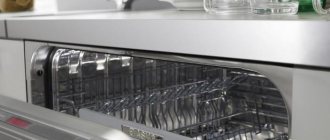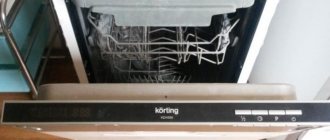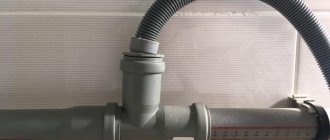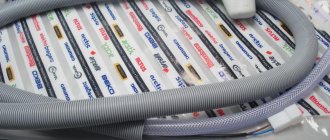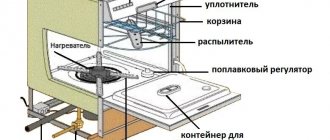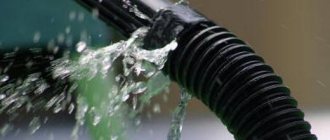An actively used dishwasher greatly simplifies the life of every housewife. When choosing this type of household appliance, many focus on appearance, but functionality is more important. To evaluate a model's usefulness, you need to know how long a dishwasher's wash cycle takes and decide whether they're right for you.
You will learn everything about the duration of standard and additional operating modes of dishwashers from our article. We will tell you how to choose equipment with the functionality that suits you personally. Thrifty housewives will find useful tips to reduce operating costs.
Dishwasher interior
At first glance, the operation of a dishwasher seems simple: install the unit, connect it, put detergents in the right places, arrange the utensils, select a program, start the equipment. Then you can forget about the dishes for a while and do something more enjoyable.
But I wonder what is happening inside the dishwasher at this time? After starting the machine, water flows into a special tray through an open valve. Enriched with detergents and regenerating salt, it heats up to the temperature you set.
The process itself is identical to washing dishes by hand. The structure and operating principle of dishwashing equipment are described in detail here. We recommend that you read this very useful information.
It depends on the program you have installed and consists of three to four stages:
- soaking if the dishes are very dirty;
- washing;
- rinsing;
- drying.
The duration of these periods is influenced by the initially set water heating temperature. The higher the threshold you set, the longer you will have to wait for the cycle to end.
The dishwasher unit consists of the following elements: control panel (1), sprayer blocks - upper and lower (2, 3), float valve (4), drain hose (5), power cable (6), supply hose (7), filter (8), intake valve (9), engine (10), pump (11), heating element (12), gasket (13), button (13), latch (14)
When soaking, which is sometimes called a pre-wash, the main dirt is washed off from the dishes with cold water without the use of chemicals from the main container. This function is convenient if dishes are loaded into the machine in stages as they accumulate. It will prevent dirt from sticking tightly to previously loaded kitchen items.
The washing itself involves treating the dishes with hot water at about 80ºC. You can simply increase the washing time, but the advantage of the first option is that no detergent components are used.
The diagram shows the process taking place inside the dishwasher. It is important to load high-quality washing products and select the correct mode before starting
Water along with the chemical composition is sprayed using special tubes located at the top or bottom of the body. The rocker washes dishes more efficiently. During rotation, it sprays water jets in all directions under powerful pressure.
At the end of the washing stage, the PMM automatically turns on the next one - rinsing and drying.
Experts do not consider pre-rinsing a mandatory procedure if the PMM is not started immediately. It is enough to simply remove residues from plates and pots so as not to clog the machine with them.
Rinsing in a dishwasher, similar to a washing machine, involves two stages. This is the only way to completely remove detergents from all surfaces of washed dishes.
Standard operating modes
Dishwasher programs are a sequence of operations that the microprocessor performs.
The main parameters are:
- Presence or absence of pre-soaking mode.
- Water heating temperature.
- Duration of the program.
After repeated use of the PMM, it will be easy to recognize how it functions and detect malfunctions by ear.
Types of drying in PMM
Drying completes the washing cycle. It comes in three types: blowing with heated air (turbo-drying), an intensive process with a heat exchanger, and condensation.
The first method involves blowing warm jets of air over the treated dishes. The implementation of the process is possible thanks to the presence of a fan built into the design. Drying occurs faster, but energy consumption is increased.
Enhanced drying is carried out due to the independent movement of air inside the housing as a result of the pressure difference. This method gives good results with more economical consumption of electricity.
The drying phase completes the operation of the machine. PMMs equipped with turbo drying are expensive, others are somewhat cheaper; when choosing, you should consider what is more important for you - a shorter drying stage or higher electricity bills
During condensation drying, drops of water evaporating from the surface of the dishes are transformed into condensation and settle on the walls, then flow down. This drying method takes a lot of time, but if there is nowhere to rush, then this method is the best.
Standard cycle time
Modes for different PMM models may differ. Still, there are four basic washing modes in a dishwasher, which each manufacturer includes in its program. These modes are called fast, normal, economical, intensive. Let's consider each of them as guidelines for choosing a dishwasher.
When choosing a quick wash, the pre-wash and dry function is no longer required. The process lasts about half an hour. In the instructions for some models, this type of dishwashing is called rinsing. This mode is used when a small amount of not very dirty dishes has accumulated.
In normal mode, which includes a fully completed cycle, the dishwasher runs for an average of two hours, of which:
- Rinse - from 5 to 10 minutes.
- Main wash – up to 50 minutes. at a water temperature of 65⁰.
- Rinse in three steps - up to 10 minutes.
- Drying - the rest of the time.
Economy mode significantly reduces time by increasing temperature and pressure. This results in less water being wasted, but energy consumption increases. The program contains a preliminary rinse, a wash at 50⁰, a double rinse, and drying.
Very dirty dishes are washed using an intensive mode for 2-3 hours. This program includes pre-rinsing, washing at 70⁰, rinsing in four steps, drying.
For efficient operation of the unit, it is necessary to place the very dirty surface of the dishes closer to the washer fluid sprayer. Knives in a dishwasher that is not equipped with a special container are placed with the blades down, and forks are placed with the teeth up
It is better to wash pans and pots in the “pre-soak” mode. Particularly greasy kitchen utensils should be kept in the sink under very hot running water before loading. This will help the dishwasher do a better job.
Some models are also equipped with the following programs:
- EatLoad-Run , which allows you to load dishes directly from the dining table. There is a quick wash at 65⁰, then rinsing and drying, and all this in 30 minutes.
- Wash delicate at 45⁰ . Used for crystal, porcelain, glass. Duration: 110 minutes.
- Car wash (Auto) - this program, without outside intervention, determines the degree of contamination and automatically sets the required amount of water, detergent and the duration of the process. The usual water temperature in this mode is from 45 to 65⁰, duration is 2 hours 40 minutes.
The latest PMM models have the Varlo Speed , which allows you to reduce time by up to 50%. Not everything is so simple here - while saving time, electricity consumption increases. When choosing a mode, you need to calculate what is more profitable for you - saving time or energy.
Floor-standing models that hold a minimum of eight sets have a half-load mode . This means that only one of the available two baskets is loaded. At the same time, the washing time is not reduced, but the volume of water, detergents, and electricity used decreases.
The variable washing program provides for simultaneous processes - washing dishes in intensive mode and soaking. These two jobs happen in different baskets. Using the program allows you to save about 25% of water while maintaining excellent washing quality.
To start the dishwasher, you need to correctly decipher the icons on the panel. Sometimes they are signed, but in the language of the country of origin
“Delay Start” function is very relevant . With its help, you can move the start by 1 – 24 hours. If you have a double tariff for electricity, this is very convenient.
Additional functions of PMM
In parallel with dishwasher modes, they can also have additional functions. Almost all of them are equipped with leakage protection. If there are small children in the house, you need a unit with the ability to lock the control panel or door.
The ability to add forgotten dishes after starting the machine is also a very convenient feature. Elite models are equipped with loading sensors. In this mode, the PMM selects both the volume of water and the time spent on the cycle.
Some models have additional elements - sensors for monitoring water purity and hardness. A sensor for monitoring the degree of water purity forces the unit to rinse everything loaded into the machine until the liquid becomes perfectly clean. If the water is very hard, the machine will determine how much softening salt to add.
The panel for launching additional functions for built-in PMM models is located at the end of the door
Built-in units in working condition project a red beam onto the floor plane. When the process is completed, it disappears or its color changes to green. This is very convenient, because... makes it possible to monitor the operation of the built-in dishwasher.
Control of washing modes
All modes in the PMM are coordinated in two ways: electromechanical and electronic. The second method is more comfortable, and all modern models are equipped with it. The first provides for the presence of buttons, switches and keys on the body, and they are controlled manually.
Control of some PMM models is simplified due to the presence of clear symbols in the designation of standard programs. These are glasses, pots and other items (+)
With electronic control, both the washing mode and other programs are set using commands. If the PMM board fails, only a specialist can repair it. Experience shows that most often the programmer will have to be changed.
The final stage of machine operation
At the end of the cycle, the contaminated liquid goes down the drain. This is followed by a drying stage. It can end in 30 minutes or last more than an hour.
A special signal sent by the device will notify you of the end of the program. The sound volume is adjusted using convenient indicators placed by the manufacturer on the control panel. With their help, you can completely disable the alert function if you plan to load the machine overnight.
When the unit stops completely, press the on/off button. Then the door is opened slightly to allow the dishes to cool faster.
After drying, a high temperature remains inside the unit, so it is not recommended to immediately empty it of its contents. In addition, cookware made from certain materials becomes very fragile when hot.
After the beep sounds indicating the end of the wash, you should wait a while before removing the dishes.
It happens that the cycle is completed, but the dishwasher does not turn off. The most likely cause is an electronic problem. This may also be a consequence of blockage of the drain hole with food debris. The machine cannot shut down correctly.
Program duration for some models
Let's see how the duration of the modes differs for individual PMM models. For this purpose, we will analyze several popular examples of dishwashers of different brands and the duration of washing with these machines.
In practice, different manufacturers set the cycle duration values to be identical. The exact time can be seen in the instructions or on the display (+)
Based on reviews from many users, we can conclude that the most frequently used modes are fast and intensive.
Factors that affect wash time
The dishwasher procedure follows the same steps as for manual cleaning. If the dishes are too dirty, pre-soaking is required. After this comes the main stage, rinsing and drying. Each stage of work lasts a certain time in accordance with the selected washing program. The higher the water temperature, the longer it will take to wash dishes. As a result, a full cycle of washing dishes in a machine lasts from 32 minutes to two hours.
Soak
If the dishes are very dirty, there are old stains and dried pieces of food, it is better to use the soaking program. The duration of the procedure is 16-19 minutes.
the washing up
Immediately after soaking (if this function was initially installed), the dishwashing process begins. It assumes the following scheme of work:
- As soon as the household appliance has taken the required amount of water, it begins heating it to the temperature of the specified function. The washing process begins.
- The machine then uses detergent.
- After these steps, water and detergent flow into the spray nozzles located at the top and bottom of the device.
- The sprayers rotate at high speed and supply hot water under pressure to soiled cutlery items that are placed on the shelves.
- After the main washing stage, the dirty water is drained into the sewer, and the next stage begins - rinsing.
See also
Recommendations on how to choose the right electric kettle
On average, a wash cycle lasts 17-24 minutes. If the heating device is in a faulty condition, the machine may not start.
Rinse
This cycle is necessary to get rid of any remaining detergent powder. The cleaning product may be harmful to human health. The rinsing process lasts 18 minutes. Rinse aid is used instead of detergent, and the water does not heat up.
Drying
Many dishwasher models have a drying program. It takes 16-19 minutes for items to dry thoroughly. In cheaper models of dishwashers, a standard type of drying is assumed. Expensive models are equipped with turbo drying. Wet objects are blown with hot air.
Water saving level in dishwashers
Both the selected washing mode and the PMM model determine how much water it will consume. On average, this is from 10 to 13 liters per procedure as a whole. Unlike manual washing, all water is used only for its intended purpose without any loss.
During the process, the working fluid is cleaned using special filters and is supplied completely renewed for rinsing. Economy modes reduce the amount of water consumed by 25%.
Water savings when using PMM are obvious. The unit uses a special technology in which the collected water is used several times
The profitability of PMM is indicated by symbols. Highly economical units are marked with the letters A, B, C. They consume 9 - 16 liters. Average-economical dishwashers are designated in the form of the letters D, E. They consume slightly more water - up to 20 liters. Low-efficiency machines with the letters F, G require 26 liters per cycle.
Recommendations for choosing a mode
To choose the right washing mode, you need to take into account the degree of dirt left on the surface of the dishes:
- If you need to rinse the dishes immediately after eating, select the quick wash mode.
- The intensive mode is designed for washing old and heavily soiled dishes.
- For daily washing of items, it is enough to select the main washing mode. The water does not heat above 55 degrees. The consumption of detergents and water is average.
- Lightly soiled dishes, as well as cups and spoons, are washed in an economical mode. The water temperature does not heat above 45 degrees. The consumption of cleaning products and water is minimal.
How to load dishes correctly?
Sometimes improper loading of dishes causes the PMM to fail to complete the programs included in it and, as a result, deteriorate the quality of washing. All the details of loading dishes into the machine are listed in our recommended article.
If you place large kitchen utensils in the center - pots, pans, baking sheets, cutting boards, trays, the flow of water will be blocked. It’s better to move it all closer to the edges or lower it into the lower compartment.
The volume of a single load depends on the dimensions of the dishwasher. Some manufacturers, in the attached instructions, describe in detail the process of placing dishes in the PMM
If there is a large amount of dishes that need to be washed, you cannot process them all at once. Water and detergents will not have sufficient free contact with the surfaces of kitchen utensils.
To do this, there must be free spaces between kitchen utensils. If the dishwasher is overloaded, it will not be able to do its job efficiently.
For the dishwasher to function properly, it is important that the powder or detergent tablets are strictly in the compartment intended for this purpose. Due to the fact that the cycle is programmed in advance, all means come into effect precisely at the set time.
If there are streaks on the dishes, this indicates excess salt or rinse aid. When there is not enough detergent, dirty streaks will remain. If you detect food residues at the bottom of the unit and on the dishes, you should check the filters. Most likely they are clogged. Experts advise cleaning them after one or two washes.
Dishes that have not been washed for a long time or that have been burnt on must be pre-cleaned by hand. When excess foam forms during rinsing, it means that you have added too much rinse aid. In this case, correct setting of the dispenser or adding a defoamer in powder form will help.
Rules of care and use
In order for the dishwasher to serve for a long time, you need to follow a number of rules in care and operation:
- Before putting the dishes into the machine, it is better to first rinse them under running water;
- to ensure that all items are better placed in the tray, use all kinds of clamps and holders;
- Do not put clothes, sponges, or towels into the dishwasher;
- the program and temperature conditions must correspond to the quality of the loaded dishes;
- It is allowed to use only suitable products that are dosed correctly according to the instructions;
- as soon as the mode has finished its work, there is no need to rush to take out the dishes;
- Filters, baskets, and washing chambers should be checked and cleaned periodically;
- After each use, you need to wipe the door, trays and cuvettes from any remaining water;
- You need to properly care for the rubber parts of the device.
If you follow all the rules, you will be able to save time, water and electricity. The device will work without interruption, leaving clean dishes after use.
Share link:
Conclusions and useful video on the topic
Processes occurring in the machine during operation:
It is difficult to wash dishes by hand in very hot water. PMM does it better. The washing time depends directly on the selected mode and model of equipment. Dishwashing equipment is also supported by the fact that its use not only saves resources, but also the time spent on daily washing of kitchen utensils.
Would you like to share your own experience in operating a dishwasher and choosing the appropriate operating cycle? Is there information on the topic of the article that will be useful to site visitors? Please write comments in the block below, post photos and ask questions about things that interest you.
The meaning of the error code and possible problems
If the dishwasher suddenly does not turn on, check: Is the door closed? Are filters and hoses passable? Is the fuse good? Is everything OK with the socket?
Some errors are reflected on the electronic display in the form of codes; below are their explanations:
- E4. Indicates that there is a blockage, inspect all hoses and filters
- E6. Often found in the Bosch Silence Plus modification. Indicates a problem with the contamination analysis sensors, for example, if you installed the program incorrectly.
- E15. This means that the anti-leak mode is activated, check if there is any water around the machine.
- E17. Problems with the water supply, check the connection to the water supply.
- E24. Inability to discharge water, possible blockage or compression of the outlet hoses.
- E27. Power failure, power surge or power outage. This can be solved by installing an uninterruptible power supply unit.
Four main washing programs
Washing and drying cycles range from 0.5 to 2.5 hours. During this time, several sets of cutlery will be washed. You can also wash pots and pans in them. True, you will have to spend your time cleaning the dishes from large leftover food, but at the same time, the rest of the time that would have to be spent on washing the plates will be freed up. The duration of the dishwasher cycle depends on the specified program, which may include:
- pre-soaking dirty dishes;
- direct washing;
- rinsing with or without conditioner;
- drying.
The cycle in which the dishes are directly washed lasts on average from 15 to 25 minutes, and rinsing lasts the same amount of time. At the end, with a given program, the machine dries the washed dishes. This takes about 20 more minutes.
Often machines have 4 washing modes, that is, 4 programs:
- Quick wash – no pre-wash, program time – 30 minutes. In several models this mode is called rinsing.
- 70 degree mode - long mode - 2 hours 20 minutes, short mode - (Bosch machines have a Time Saving function (Vario Speed) - 1 hour 30 minutes.
- Eco 50 degrees is the most optimal mode, long mode – 2 hours, shortened mode (Vario Speed) – 1 hour 20 minutes.
- Auto – 45-65 degrees – 2 hours 40 minutes.
Bosch dishwasher operating programs.
The fastest program has a low temperature (about 35 degrees). Its duration does not exceed 30 minutes. A regular wash takes 1.5 hours, and the water heats up to 65 degrees. At this time, triple rinsing and drying is started.
An economical program consists of pre-soaking cutlery, washing at a temperature of 50 degrees, rinsing with a double change of water and final drying of the dishes. You will have to wait longer for this program to finish – approximately 2.5 hours.
Duration of the program (washing) using the example of the Hotpoint-Ariston LTF 11M121 dishwasher.
For the dirtiest dishes, use the automatic intensive wash mode. In this case, the dishes are soaked and then washed at 70 degrees. After this, rinsing occurs four times, and at the end of the regime, the dishes are dried. The duration of such a program is a little more than 2.5 hours.
Some machines, for example, from Bosch, have other modes:
- Quick wash immediately after eating. The duration of the mode is 30 minutes.
- Delicate washing of cutlery made of crystal, porcelain or glass at a temperature of 45 degrees.
- Automatic washing, in which the machine itself determines the degree of soiling of the dishes, calculates the consumption of water and powder, and also programs the cycle duration.
- The time saving function reduces it by up to half, however, this increases energy consumption.
- Express mode involves incomplete loading of the machine, in which drying is not provided. The entire washing process takes 15-20 minutes.
- For example: at 65 degrees in a Bosch SPS 40E42 machine, drying and washing take exactly 1.5 hours.
Having a dishwasher is especially important after celebrations and large feasts. The housewife will not have to wash dirty dishes until late at night. Simply load your appliances onto the racks and come out in the morning clean and sparkling, including pots, pans and baking trays.
How a dishwasher works
After pressing the “Start” button, a fascinating washing process begins that cannot be seen. You can only hear water being drawn, dishes being washed and dried. It's time to lift the veil of secrecy and figure out exactly how the dishwasher actually does the washing.
Useful for washing:
- water softening salt;
- detergent. Strong may be used. When washed by hand, this will most likely harm the skin of your hands. It is available in tablet or powder form;
- rinse aid
One of the advantages is that no special cleaning equipment is required: sponges, brushes. It should be remembered that loading dishes must be done according to the rules. Otherwise it will not be washed well enough.
A dishwasher is designed to hold a certain number of dishes. Usually this is from 6 to 12 sets.
After loading the dishes, you need to select the desired program. The principle itself consists of certain stages following each other.
Collection and preparation of water
This is the first stage. On it, a predetermined amount of water begins to flow into the dishwasher. Most often it is cold. However, some models have connections to both cold and hot water at the same time. It passes through an ion exchanger, gets rid of unnecessary impurities, and softens. Mixed with detergent that was previously poured into the machine.
Next it heats up to a certain temperature that was set. This is facilitated by a special heating element or flow-through heater. A heating element is a heating element, like a kettle. It is able to heat water evenly. Flowing heats water faster, but also consumes more energy. Replacing the heating element will be much cheaper if it breaks.
Pressure spraying of working solution
Water, prepared in advance, enters the upper and lower sprinklers under pressure. Some models also have side ones. Thanks to the rotation of the rocker arms, water flows into all areas of the chamber, and the dishes are completely washed. There are no places where water can get in.
The dishes are wetted with a powerful stream of hot water, washing away dried food residues. The used water flows to the bottom, is filtered and re-supplied to the sprinklers. This process is repeated for the entire time specified by the program. At the end, the contaminated water is drained into the sewer, followed by clean water.
Rinse
The penultimate stage involves rinsing the dishes. Liquid rinse aid is added to the water. As during the washing process, water enters the spray arms and washes away any remaining dirt and detergent from the dishes in a large flow. Depending on the selected program, rinsing can be carried out once or twice. After completion, the water is drained into the sewer.
Drying
Washing the dishes is not the end. At the end it must be dried. A longer method is to evaporate moisture from the dishes. All condensate flows into the sewer.
How long does it take to wash dishes?
The time set for washing dishes varies from 25 to 160 minutes. A program with soak and pre-rinse will wash dishes for 20 minutes longer. The time can still increase by 20 minutes if the water is set at 70 degrees. The time depends on the selected washing program.
Here are some of the most popular modes:
- intensive – used for washing very dirty dishes. Water with a temperature of 70 degrees. Time – 60 minutes;
- normal – 100 minutes. The mode includes drying and additional rinsing;
- fast - 30 minutes. Copes with light stains;
- economical - 120 minutes. Saves resources. Standard contamination is possible.
After the dishes are washed, you need to wait some more time. You need to let the dishes cool.
Types of errors on devices with a digital display
This type of error is not standardized, so this section will look at some options for displaying it on various panels. In order to find out how to eliminate them, a digital code (for example, E4) will be given at the end, which will be deciphered in the next section. We remind you, do not forget to put your Bosch dishwasher into service mode.
A panel that displays up to three digits:
- - No problem,
- 1 – faulty water supply indicator (E6),
- 2 – error in the water heating system (E01),
- 4 – the tank is not filled (E3),
- 8 – thermometer failure (E2),
- 16 – malfunction of the flow regulator (E4).
Panel (display) with two lines:
- S3 – no problems found,
- A or B – error in receiving data from the aqua sensor (E6),
- E – no signal is received from the flow switch (E4),
- F – water does not enter the working cavity (E3),
- G – flow switch does not stop (E5),
- H – problems with the heating element (E01),
- K – short circuit or wiring fault (E2).
Most modern Bosch dishwashers are equipped with such digital panels. Error indicators will light up on them if the dishwashing process failed to start. This facilitates the diagnostic process, and therefore the speed of repair. It is highly not recommended to repair such complex equipment yourself. Contact the appropriate service center. We remind you, do not forget to put your Bosch dishwasher into service mode.
- Uniform flashing of all indicators - software failure,
- E01 – control unit failure,
- E1, F1 – sensor malfunctions,
- E02 – wiring break,
- E2, F2 – heating errors,
- E03 – drying does not occur,
- E3, F3 – the tank is not filling,
- E04 – see E02,
- E4, F4 – malfunction of the spray mechanism,
- E05 – see E01,
- E5, F5 – leakage or overflow of the tank,
- E06 – chamber is not sealed (problems with the locking mechanism),
- E6, F6 – incoming water quality sensor failure,
- E07 – fan failure,
- E7, F7 – drain pipe clogged,
- E8, F8, E08 low water level,
- E9, F9, E09 – problems with power supply to the heating system,
- E10, F10 – see E03, E07,
- E11, F11 – no data from temperature sensor,
- E12, F12 – contamination of the heating element with limescale,
- E13, F13 – incoming water temperature is too high,
- E14, F14 error in the water distribution system,
- E15, F15 – tank leakage,
- E16, F16 – valve leakage,
- E17, F17 incoming water pressure is too powerful,
- E18, F18 – see E3, E14,
- E19, F19 – malfunction in the system,
- E20, F20 – problems with the pump,
- E21, F21 – see E3, E20,
- E22, F22 – clogged drain system,
- E23, F23 – breakdown of the pump responsible for removing water from the tank,
- E24, F24, E25, F25 – see E22,
- E26, F26 – flow sensor failure,
- E27, F27 – problems with the electrical network,
- E28, F28 – see E6,
- E29, E30, F29, F30 – see E27.
We suggest you read: Traces of sealant on the bathroom, how to get rid of stains
Resource consumption per washing cycle
One of the important issues that concerns consumers is the consumption of resources, namely water, during one washing cycle. Can you really save money? To answer this question with confidence and accuracy, you need to study the characteristics of the selected dishwasher. Basically, in the instructions, the manufacturer indicates the average consumption for one washing cycle, but if you try, you can find information about what the consumption will be for a certain cycle.
On average, water consumption ranges from 10 to 13 liters completely per cycle. When washing dishes by hand, water consumption is much higher, since the tap does not close when washing utensils. It turns out that 50% of the resource is wasted just like that.
In dishwashing equipment, the water is not drained until the end of its operation, but is only filtered and returned clean to the top to begin rinsing the dishes.
Another issue that worries consumers is energy consumption. Modern models of dishwashers, as already noted, consume up to 13 liters per cycle. In this case, the electricity consumption is 1 kW per hour. It is quite economical.
The variable wash program provides for simultaneous washing of dishes using intensive mode and soaking. These processes are performed in different baskets. The use of the specified dishwashing program makes it possible to save approximately 25% of water, while maintaining good washing quality.
Types of faults
Most problems that can occur with a Bosch dishwasher do not lead to its complete failure. Modern equipment is equipped with sensors that prevent them from starting if any part is in poor condition. The user will be notified of this either by flashing indicators or an error code on the display of the Bosch dishwasher.
Moreover, the exact startup error can only be determined by putting your dishwasher into service mode. To do this, you need to hold down a combination of some indicators on the panel, which is described in the instructions. Those signals that can be seen in normal mode give only an approximate indication of the problem.
Water consumption
One of the main questions of the consumer is how much water does a dishwasher consume per cycle? Are the savings really happening?
In the machine, the water is not drained until the end of the work; it only passes through special filters and is returned clean to the top for rinsing the dishes. Additional savings are also generated due to the fact that washing occurs with the help of sprayers, that is, the dishes are washed not with a jet, as with manual washing, but with small splashes. You can reduce water consumption by 20-30% by choosing economical operating modes. It is worth noting that the size of the device does not play a special role.
Pay attention to the level of efficiency before purchasing; as a rule, it is indicated by letters:
- A, B, C - dishwashers that consume from 9 to 16 liters are called highly economical machines;
- D, E - machines that use water in a volume of up to 20 liters are classified as average economic;
- F, G - dishwashers that consume water up to 26 liters per cycle are low-efficiency.
Class A dishwashers not only save water, but are also leaders in minimal energy consumption.
What to look for when purchasing?
Before purchasing, you should know how many dishes you plan to put in the machine; pay attention to the number of baskets for this. The size and type of dishwasher depend on the intended installation location; one buyer prefers built-in appliances, another prefers a tabletop option
Notice how quiet the dishwasher cycle is. The control panel should be clear and convenient
It is better to abandon complex technology if you are unable to disassemble most of the buttons
The control panel should be clear and convenient. It is better to abandon complex technology if you are unable to disassemble most of the buttons.
Entrust the installation and connection of the dishwasher to professionals, this will give you an additional guarantee and confidence in the correct operation of the machine. Ask them to run the machine once in front of you to ensure that the equipment is working properly.


